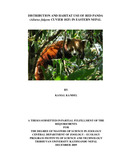Please use this identifier to cite or link to this item:
https://elibrary.tucl.edu.np/handle/123456789/3541| Title: | Distribution and Habitat Use of Red Panda (Ailurus Fulgens Cuvier 1825) in Eastern Nepal |
| Authors: | Kandel, Kamal |
| Keywords: | Red Panda;Community Forest |
| Issue Date: | 2009 |
| Publisher: | Central Department of Zoology |
| Institute Name: | Central Department of Zoology |
| Level: | Masters |
| Abstract: | Red panda (Ailurus fulgens), a habitat specialist of Himalaya, were studied in Hangetham and Choyatar CF of Eastern Nepal. Altogether 10 transects summing to 18.7km were established along with 187 systematic and 28 sign plots comprising of 3 units (10x10m 2 , 5x5m 2 and 1x1m 2 ). The fecal groups of red panda was found in 6.91% (n=13) of the systematic plots. The evidences were scattered from 2200m to 2900m asl in the study area with index of sign abundance in between altitudinal range of 2700-2900m asl (42.85/ha / 12.14/km). Red panda used trees as defecation sites (substrate) most frequently (44.05%) followed by rock (33.33%), forest floor (11.90%), fallen logs (9.52%) and cut stumps (1.20%) and differed significantly (χ 2 = 53.97, df=4, p<0.05). Availability of water source (mean=40.17±6.53m) differed significantly within its different categories (χ = 1.1.83, df=4, p<0.05), as 61.90% of fecal groups were found 0-25m away from sign centered plots. Red panda used steep slopes of 40 0 more often (76.19%) and northern faces. More fecal groups (36.90% and 46.43%) were found in 26-50% range of overstory crown canopy and understory bamboo cover. Mann-Whitney U test showed six habitat variables (slope, bamboo cover, bamboo height, bamboo diameter, proportion of dry bamboo shoots, and shrub density) differed significantly (P<0.05) between systematic and red panda sign plots and therefore are important elements of the red panda habitat. Three individuals of red panda were sighted in two sighting incidents during the study. A carcass of red panda was also found which was supposed to be predated upon by Mountain Hawk Eagle (Spizaetus nipalensis). Inadequate species level awareness in the local community about red panda’s ecological importance and high dependency on its habitat for people’s livelihood is creating its survival pressure. For effective conservation of this species, it requires not only the considerations of red panda but also the wellbeing of dependent local community. Furthermore, it is needed the intense research on its spatial distribution, specific habitat requirements and threats on broader scale. Keywords: Red Panda, Community Forest, Eastern Nepal, distribution, conservation |
| URI: | http://elibrary.tucl.edu.np/handle/123456789/3541 |
| Appears in Collections: | Zoology |
Files in This Item:
| File | Description | Size | Format | |
|---|---|---|---|---|
| Distribution and Habitat use of Red Panda (Ailurus fulgens C.pdf | 1.78 MB | Adobe PDF |  View/Open |
Items in DSpace are protected by copyright, with all rights reserved, unless otherwise indicated.
